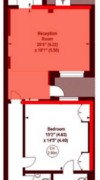Hi all,
I'm in the final stages of the buying process of a lower ground floor/garden flat (first time buyer so nervous times!).
Now as the flat evidently has damp, and I had a damp survey done with a local specialist. He confirmed that parts of the walls and flooring had damp in it and needed damp treatment, which was expected.
However, one important thing for me is very unclear: In the Damp specialist report it said that a layer of Screed with a thickness of 3-4 millimetre would be laid down, before a new wooden floor can be put in, with a drying time of just a few days.
However, every where on internet I seem to read that a layer of Screed needs to be 3 - 4 centimetre thick. This would have large implications on the time I could potentially move in (assuming 1mm per day of drying) and would also require more work I guess with making door post level etc.
I'm a bit confused and worried by this, so it would be super grateful if someone has some advice on this.
Thank you so much for any advice!
J
I'm in the final stages of the buying process of a lower ground floor/garden flat (first time buyer so nervous times!).
Now as the flat evidently has damp, and I had a damp survey done with a local specialist. He confirmed that parts of the walls and flooring had damp in it and needed damp treatment, which was expected.
However, one important thing for me is very unclear: In the Damp specialist report it said that a layer of Screed with a thickness of 3-4 millimetre would be laid down, before a new wooden floor can be put in, with a drying time of just a few days.
However, every where on internet I seem to read that a layer of Screed needs to be 3 - 4 centimetre thick. This would have large implications on the time I could potentially move in (assuming 1mm per day of drying) and would also require more work I guess with making door post level etc.
I'm a bit confused and worried by this, so it would be super grateful if someone has some advice on this.
Thank you so much for any advice!
J


